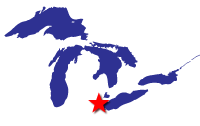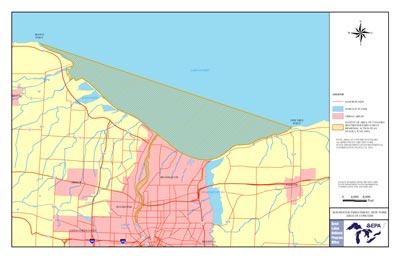Rochester Embayment AOC
Contact Us
Mary Beth Giancarlo
(Giancarlo.Marybeth@epa.gov)
312-886-2253
Latest News
Overview
Rochester Embayment is one of the 31 United States’ Areas of Concern (AOCs) designated under the 1987 Great Lakes Water Quality Agreement.
The Rochester Embayment is a broad bay on the south shore of Lake Ontario at the mouth of the Genesee River. The Rochester Embayment AOC is defined as the approximately 35 square mile portion of Lake Ontario between Nine Mile Point in the Town of Webster (Monroe County, Lake Ontario Central Basin) and Bogus Point in the Town of Parma (Monroe County, Lake Ontario West Basin). The AOC also includes the approximately six-mile reach of the Genesee River, from the Lower Falls to the mouth, that is influenced by water levels in Lake Ontario.
Before the onset of modern-day environmental laws, manufacturing facilities located in and near the AOC contributed to the contamination of its watersheds. That historic contamination also caused serious degradation to an unnamed tributary of Brockport Creek and sediment found in the Rochester Embayment with:
- Polychlorinated Biphenyls
- Cyanide
- Dioxins
- Furans
- Silver
Beneficial Use Impairments
An interim success of remediation and restoration work is removing Beneficial Use Impairments (BUIs). BUIs are designations given by the International Joint Commission, representing different types of significant environmental degradation. As cleanup work is completed, and monitoring demonstrates sufficient environmental health improvements, BUIs can gradually be removed. The list below shows which BUIs have been removed and which remain. Once all BUIs are removed, the process of delisting the AOC can begin.
- Restrictions on Fish and Wildlife Consumption – REMOVED 2021
- Tainting of Fish and Wildlife Flavor – REMOVED 2018
- Degradation of Fish and Wildlife Populations- Under Review for Removal
- Fish Tumors or Other Deformities – REMOVED 2015
- Bird and Animal Deformities or Reproductive Problems
- Degradation of Benthos – REMOVED 2017
- Restriction on Dredging Activities – REMOVED 2019
- Eutrophication or Undesirable Algae – REMOVED 2019
- Restrictions on Drinking Water Consumption, or Taste/Odor problems – REMOVED 2011
- Beach Closings – REMOVED 2019
- Degradation of Aesthetics - Under Review for Removal
- Added Costs to Agriculture or Industry – REMOVED 2011
- Degradation of Phytoplankton and Zooplankton Populations – REMOVED 2016
- Loss of Fish and Wildlife Habitat
- General information about BUIs: Beneficial Use Impairments for the Great Lakes AOCs
Remediation and Restoration Work
The federal, state and local governments, working with their partners, have made significant progress in addressing the environmental challenges in the Rochester Embayment, particularly in the areas of protecting and restoring fish and wildlife habitat, and in beach improvements. These accomplishments include developing habitat management plans for Braddock Bay, algae reduction around Charlotte Beach, and comprehensive assessments of fish, sediment and aquatic animals. These assessments demonstrate that the Rochester Embayment’s resources are now improving and with continued restoration efforts will become healthy clean habitats for humans and wildlife.
- Documents on Restoring Rochester Embayment AOC
- Remediation and Restoration Projects for Rochester Embayment AOC
Restoration Project Highlights
Braddock Bay
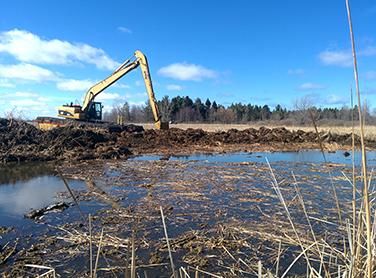 Wetland Restoration in progress at Braddock Bay. Photo Credit: Josh UnghireThe Braddock Bay habitat restoration project focused on restoring 340-acres of wetland habitats and re- establishing a barrier beach, serving as a breakwater to protect the bay and newly restored habitats. Restoration crews dug channels and potholes throughout surrounding wetlands of Braddock Bay to enhance fish and wildlife habitat features - increasing the plant and animal diversity in the area. These channels and potholes were created strategically to reopen surface waters to wildlife and allow fish species to better navigate through the wetlands by establishing varied depths to accommodate fishes of varying sizes and foraging preferences. These features also allow fishes to navigate into spawning habitats that were once inaccessible due to invasive species and overgrowth. With the establishment of historically native vegetation, reopened surface waters enhanced habitat features throughout Braddock Bay. Several species have been documented returning to the area to make use of the natural enhancements, including the federally endangered piping plover.
Wetland Restoration in progress at Braddock Bay. Photo Credit: Josh UnghireThe Braddock Bay habitat restoration project focused on restoring 340-acres of wetland habitats and re- establishing a barrier beach, serving as a breakwater to protect the bay and newly restored habitats. Restoration crews dug channels and potholes throughout surrounding wetlands of Braddock Bay to enhance fish and wildlife habitat features - increasing the plant and animal diversity in the area. These channels and potholes were created strategically to reopen surface waters to wildlife and allow fish species to better navigate through the wetlands by establishing varied depths to accommodate fishes of varying sizes and foraging preferences. These features also allow fishes to navigate into spawning habitats that were once inaccessible due to invasive species and overgrowth. With the establishment of historically native vegetation, reopened surface waters enhanced habitat features throughout Braddock Bay. Several species have been documented returning to the area to make use of the natural enhancements, including the federally endangered piping plover.
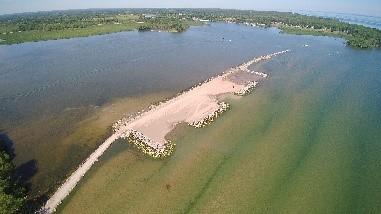 Aerial Photo of the construction of the barrier beach in Braddock Bay. Photo Credit: United States Army Corp of EngineersThe re-established beach provides added protection to the restored habitats and wetlands and it also creates a safe harbor for vessels on Lake Ontario. The increased protection for boaters and recreation activities will help revitalize economic opportunities by attracting visitors to the area to take advantage of the new barrier beach and restored habitat. Through partnerships with U.S. Fish and Wildlife Service, U.S. Army Corps of Engineers and EPA, this habitat restoration project will advance Rochester Embayment AOC towards delisting by addressing the Loss of Fish and Wildlife Habitat BUI.
Aerial Photo of the construction of the barrier beach in Braddock Bay. Photo Credit: United States Army Corp of EngineersThe re-established beach provides added protection to the restored habitats and wetlands and it also creates a safe harbor for vessels on Lake Ontario. The increased protection for boaters and recreation activities will help revitalize economic opportunities by attracting visitors to the area to take advantage of the new barrier beach and restored habitat. Through partnerships with U.S. Fish and Wildlife Service, U.S. Army Corps of Engineers and EPA, this habitat restoration project will advance Rochester Embayment AOC towards delisting by addressing the Loss of Fish and Wildlife Habitat BUI.
Buck Pond Restoration
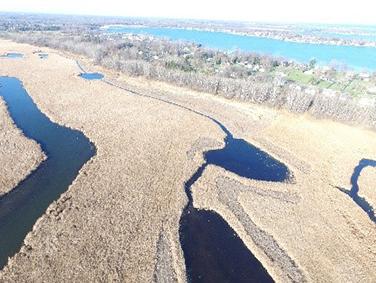 Aerial view of the newly constructed channels and potholes in Buck Pond. Photo Credit: Ducks Unlimited and SUNY BrockportThe Buck Pond complex marsh system had become inundated with invasive vegetation that grew too thick for wildlife to navigate and changed the size and shape of the wetland. Through a Great Lakes Restoration Initiative (GLRI) grant in 2014, Ducks Unlimited and SUNY Brockport were able to restore Buck Pond’s native vegetation throughout the 205-acre wetland. The restoration project created over 7-acres of pothole formations, 20-acres of sedge meadow and over 6,654 linear feet of channeling throughout Buck Pond, restoring crucial wildlife habitat.
Aerial view of the newly constructed channels and potholes in Buck Pond. Photo Credit: Ducks Unlimited and SUNY BrockportThe Buck Pond complex marsh system had become inundated with invasive vegetation that grew too thick for wildlife to navigate and changed the size and shape of the wetland. Through a Great Lakes Restoration Initiative (GLRI) grant in 2014, Ducks Unlimited and SUNY Brockport were able to restore Buck Pond’s native vegetation throughout the 205-acre wetland. The restoration project created over 7-acres of pothole formations, 20-acres of sedge meadow and over 6,654 linear feet of channeling throughout Buck Pond, restoring crucial wildlife habitat.
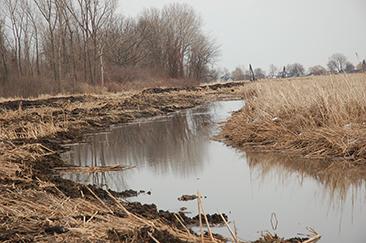 These restored channels allow for better water flow and allow wildlife to utilize the wetland. Photo Credit: Ducks Unlimited and SUNY Brockport
These restored channels allow for better water flow and allow wildlife to utilize the wetland. Photo Credit: Ducks Unlimited and SUNY Brockport
Cattail debris removed to create the potholes and channels was then used to build 15-acres of small habitat mounds in the wetland for native grasses and sedges to establish. Wildlife can once again make use of Buck Pond wetland; muskrats and northern pike have already moved back into areas that were once too dense to navigate.
By removing invasive species and restoring habitat, the Buck Pond project will have a significant impact on the delisting of the Rochester Embayment AOC by addressing the Loss of Fish and Wildlife Habitat BUI.
Partners
The following links exit the site Exit

